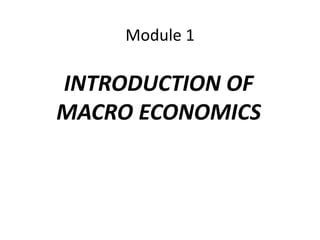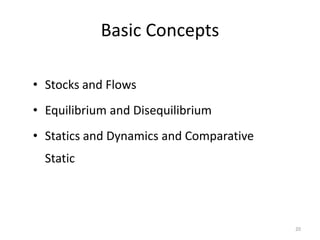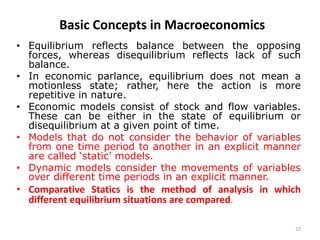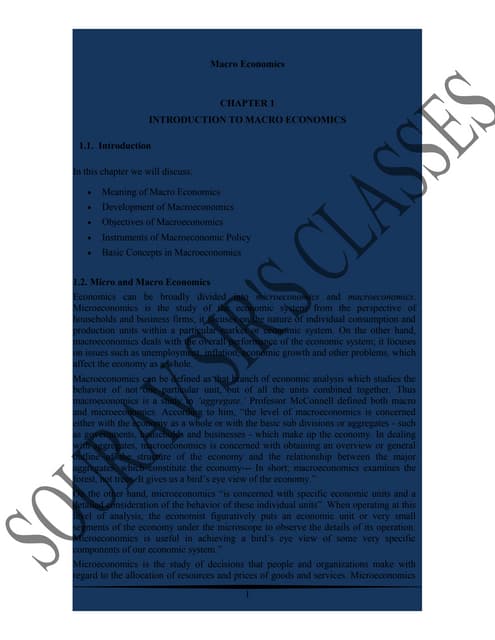intro to macro.ppt
- 1. Module 1 INTRODUCTION OF MACRO ECONOMICS
- 2. 2 Session Outline âĒ Classification of economics âĒ Development of macroeconomics âĒ Meaning and Definition of macro Economics âĒ Nature and Scope of Macro Economics âĒ Importance of macro Economics âĒ Limitations of macro Economics âĒ Macro Problems âĒ Macro Theories âĒ Basic concepts of macroeconomics âĒ Policy instruments âĒ Diagnosing health of the economy âĒ Circular flow of income âĒ Interdependence of Micro and Macro âĒ Micro Vs Macro
- 3. 3 Classification of Economics âĒ Macroeconomics âĒ Microeconomics
- 4. 4 âĒ Microeconomics deals with the behavior of individual entities like individuals, markets, firms, households, etc. âĒ Thus it looks into the micro aspects of the economy, whereas macro economics studies the broader aspects of the economy and studies the behavior of an economy as a whole. Development of Macroeconomics
- 5. 5 Development of Macroeconomics âĒ Keynes pioneered a new approach to macroeconomics and macroeconomic policy. âĒ Any discussion on macroeconomics starts with J M Keynes, the famous economist.
- 6. 6 âĒ Prior to Keynes, the business cycles were considered to be inevitable, and there was no concrete approach to solve these problems. These economists known as Classical economists focused only on the micro aspects of the economy. The Great Depression of 1930s left many of these economists helpless. âĒ In this backdrop, Keynes came up with a new approach to look at the economy. In his book, 'The General Theory of Employment, Interests and Money'. Development of Macroeconomics
- 7. 7 âĒ Keynes argued that it is possible that high unemployment and underutilization of the capacities may take place and continue in the market economy. He also argued that government can play a bigger role during the economic depressions by effective utilization of monetary and fiscal policies. âĒ After the World War II, the focus of economics was just aimed at countering unemployment and inflation, and some economists proposed a fixed money growth rate to address these issues like inflation and unemployment. Hence these economists were called as monetarists as they have given importance to money. Development of Macroeconomics
- 8. 8 Development of Macroeconomics âĒ In the last few decades, another school of thought has gained prominence among noted economists. These economists opine that people should be given enough incentives for their earnings, rather than imposing taxes on their earnings. This group of economists advocates incentives for savings, known as supply side economists.
- 9. MEANING OF MACRO ECONOMICS âĒ According to Prof. Ackley,â Macro Economics deals with the economic affairs in the large, it concerns the overall dimensions of economic life.â âĒ Macro economics is the study of aggregate behaviour of the economy as a whole. âĒ It is concerned with the Macro Economic Problems such as growth of output and employment, NI, Rates of Inflation and Deflation , BOP, Trade cycles , Exchange Rates, Total Investment, Total Demand, etcâĶâĶâĶ.. âĒ It is the study of Interrelationships among these various aggregates.
- 10. Scope of Macro Economics 1. Theory of national Income 2. Theory of Output and Employment 3. Theory of Prices 4. Theory of Economic Growth 5. Theory of International Trade 6. Theory of Business Cycles 7. Theory of Distribution
- 11. Importance of Macro Economics 1. Formulation of Successful Economic Policies 2. Regulation and Control of entire economy 3. Study large and Complex developing Micro Economics 4. Tracing of Economic Problem. 5. Helpful in Economic Planning 6. Study of changes in Price level 7. Study of Theories of shifting Equilibrium 8. Helpful in understanding the Dis-equilibrium in BOP 9. Full employment 10. High living standards 11.Reduction of economic inequality 12.Rapid economic growth 13.Steady foreign exchange position
- 13. 13 High level of output (GDP) âĒ The ultimate aim of any economy is to provide the desired goods and services. The economy should be in a position to offer these goods and services in ample number. To measure the output of any economy, Gross Domestic Product (GDP) is the most comprehensive estimate. GDP measures the market value of the entire output in a country during a particular year. âĒ There are two variants in GDP- Nominal and Real. When nominal GDP is adjusted for inflation, it gives real GDP. âĒ The importance of GDP can be analyzed by the fact that any predictions regarding the future growth or fall in the economy or date on the past economic performances are made in the GDP percentage. In the recent figures released by the Central Statistical Organization, Indiaâs economy grew by 9.4%, in the second quarter of 2007.
- 14. 14 Price Stability âĒ Stable prices are the third macroeconomic objective. Consumer price index (CPI) is the most commonly used measure of overall price level in an economy. CPI is the measure of the cost of different types of goods bought by the average customer. Inflation denotes the rise or fall in general price level in the economy. Inflation rates, shows the rate of change in the price index. When the inflation is high, the purchasing power of the customers reduces. âĒ A negative fall in the prices is known as deflation, as witnessed during the Great Depression of 1930s. Whereas, hyperinflation refers to the rise in prices by thousands of percentage points, resulting in the collapse of the price systems. Hyperinflation was witnessed in Weimer Germany in the 1920s and again in Brazil in 1980s and Russia in 1990s.
- 15. 15 Sustainable Balance of Payments âĒ Globalization has resulted in increased transactions between a country and the rest of the world. Balance of Payments records all these transactions, both imports and exports. Countries keep a close watch on their international trade. âĒ The barometer that shows the efficiency of international trade is the net exports. It is the difference between the value of exports and value of imports. Net exports are also called as the balance of trade. âĒ Every country desires to have a positive balance of trade.
- 16. 16 Economic growth âĒ Every country wishes to and strives for having a constant growth in its economy. There are two parameters that judge the rate of growth that an economy achieves. ï· Increase in production possibility curve or schedule ï· Growth in GDP or per capita income âĒ If GDP is growing at g% per annum and population at p%, per capita GDP must be growing by= ï(1+g / (1+p)ï - 1
- 17. Limitations of Macro Economics 1. Fallacy of Composition 2. To regard the Aggregates as Homogeneous 3. Aggregate Variables may not be important Necessarily 4. Indiscriminate Use of Macro Economics misleading 5. Statistical and Conceptual Difficulties.
- 18. Macro Problems 1. Disequilibrium in BOP 2. Level of Unemployment 3. Low level of Aggregate Demand 4. Inflation and Deflation 5. Situation of Depression 6. Lack of Investment 7. Less Economic Growth
- 19. Macro Theories 1. Theory of National Income 2. Theories of Income, Output and Employment 3. Theories of Investment 4. Theories of Money 5. Theories of Interest Rates 6. Theories of Inflation 7. Theories of Business Cycles 8. Theories of Growth
- 20. 20 Basic Concepts âĒ Stocks and Flows âĒ Equilibrium and Disequilibrium âĒ Statics and Dynamics and Comparative Static
- 21. 21 Basic Concepts in Macroeconomics âĒ In macroeconomics study, various variables are used. Some are stock variables and some are flow variables. Variables like money supply, CPI, Foreign exchange reserves, which can be measured at any given point of time are called as stock variable. âĒ Whereas variables like GDP, inflation, imports, consumption and investment, which can be measured only over a period of time, are flow variables.
- 22. 22 Basic Concepts in Macroeconomics âĒ Equilibrium reflects balance between the opposing forces, whereas disequilibrium reflects lack of such balance. âĒ In economic parlance, equilibrium does not mean a motionless state; rather, here the action is more repetitive in nature. âĒ Economic models consist of stock and flow variables. These can be either in the state of equilibrium or disequilibrium at a given point of time. âĒ Models that do not consider the behavior of variables from one time period to another in an explicit manner are called âstaticâ models. âĒ Dynamic models consider the movements of variables over different time periods in an explicit manner. âĒ Comparative Statics is the method of analysis in which different equilibrium situations are compared.
- 23. 23 Diagnosing Health of the Economy âĒ National Product and Domestic Product âĒ Aggregate Consumption âĒ Gross Domestic Savings âĒ Gross Domestic Capital Formation âĒ Wholesale Prices, Consumer Prices and Inflation âĒ Employment âĒ Balance of Payments âĒ Rate of Growth
- 24. 24 Policy Instruments âĒ Fiscal Policy âĒ Monetary Policy
- 25. 25 Fiscal Policy âĒ Fiscal policy is concerned with the use of taxes and government expenditures. Government has to meet various expenditures like salaries, defense expenses, infrastructure development, etc. Another part of government expenditure also goes in the form of transfer payments like financial assistance to the elderly and unemployed. All these expenses leave a positive effect on the overall economy. The impact of government spending is also felt on the overall spending in the economy, thus influencing the size of the GDP.
- 26. 26 Fiscal policy âĒ The other part of the fiscal policy is generation of revenues for the government. Taxes are the main source of revenue for any government. Taxes affect the economy and the individuals in two ways. First, taxes imposed on the income of the people bring down the disposable income in the hands of the consumers. This reduces the spending in the economy. Second, the taxes levied on goods and services make them costlier. This discourages the firm to invest in capital goods.
- 27. 27 Monetary Policy âĒ Monetary policy is the second most widely used macroeconomic policy instrument. Monetary policy helps government, managing the nationâs money, credit, and banking system. There are various entities that are part of the monetary system of an economy. Central bank regulates the monetary system, and other entities like banks, insurance companies, NBFCs are also a part of the monetary system.
- 28. 28 Monetary Policy âĒ In India, Reserve Bank of India is the custodian of the monetary system of the economy. Central bank brings changes in the interest rates, reserve requirements, etc. These changes make significant impact on the overall functioning of the economy. âĒ For example, the lowering of interest rates on housing loans helped the growth of the housing sector. As a result of low rate of interest, it became easier to avail a housing loan and to own a house. This has resulted in the growth of many allied industries as well.
- 29. 29 Exchange Rate Policy âĒ Exchange rates are determined by the demand and supply functions. âĒ India follows a flexible exchange rate policy, which is determined by the demand and supply, where RBI has a right to intervene in the market. In order to regulate the foreign exchange transactions, government has come out with an act FERA, which was replaced by Foreign exchange management act (FEMA).
- 30. 30 Employment Policy âĒ Employment policies are adopted by government in order to increase the employment level in the country. As a part of this policy, governments come out with various polices. For example, in India, government has introduced various policies and schemes like, Jawahar Rozgar Yojna etc.
- 31. 31 Price and Incomes Policy âĒ This policy aims at regulating the prices in the market and also to ensure the minimum wages to the workers.
- 32. 32 International Trade Policy âĒ Globalization has given a big push to the international trade. This has resulted in framing of specific polices by many countries to cope with the new challenges. International trade policy addresses issues like tariff and non tariff barriers. âĒ In line with the changing economic scenario, government came out with export-import (EXIM) policy in 1997. The policyâs primary aim is to increase the exports. It has been renamed as foreign trade policy to reflect the new approach. âĒ Example: The recent policy announced in January 2006 has taken up a series of policy initiatives to fine tune the policy 2002-07. The policy aims at bringing down the transaction costs, accelerating the exports and making the country a manufacturing hub for quality goods and services. SEZs to promote not only manufactured goods but also agricultural products. Special emphasis is placed on exploiting Indian Labour skills to further exports.
- 33. 33 The Circular Flow of Income âĒ Two Sector Economy âĒ Closed Economy âĒ Open Economy
- 34. 34 Two-Sector Economy (When All Income is Consumed) Household Sector Private Consumption (C) Rs.1000 Productive Sector Wages and Profits (i.e. income (Y) Rs.1000 C Y C AD AD Y ium AtEquilibr ï― ï ï― ï― :
- 35. 35 Closed Economy Household Sector Private Consumption (C) Rs.800 Productive Sector Wages and Profits (i.e. income (Y) Rs.1000 Savings (S) Rs.200 Investment Rs.200 I S ium InEquilibr I C S C AD AD Y ium AtEquilibr ï― ïŦ ï― ïŦ ï― ï― :
- 36. 36 Open Economy Household Sector Private Consumption (C) Rs.800 Productive Sector Wages and Profits (i.e. income (Y) Rs.1000 Savings (S) Rs.100 Imports (M) Rs.50 Taxes (T) Rs.50 [Withdrawals (W) Rs.200] Investment (I) Rs.80 Exports (E) Rs.60 Government Expenditure (G) Rs.60 [Injections (J) Rs.200] J C X G I C Y AD Y ium AtEquilibr ïŦ ïï― ïŦ ïŦ ïŦ ï― ï― :



































![36
Open Economy
Household Sector
Private Consumption
(C) Rs.800
Productive Sector
Wages and Profits (i.e.
income (Y) Rs.1000
Savings (S) Rs.100
Imports (M) Rs.50
Taxes (T) Rs.50
[Withdrawals (W) Rs.200]
Investment (I) Rs.80
Exports (E) Rs.60
Government
Expenditure (G) Rs.60
[Injections (J) Rs.200]
J
C
X
G
I
C
Y
AD
Y
ium
AtEquilibr
ïŦ
ïï―
ïŦ
ïŦ
ïŦ
ï―
ï―
:](https://image.slidesharecdn.com/introtomacro-230409122951-2b434ac1/85/intro-to-macro-ppt-36-320.jpg)



































































